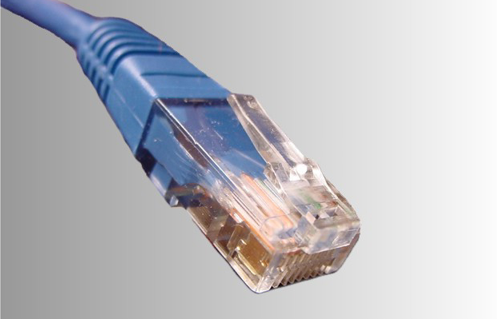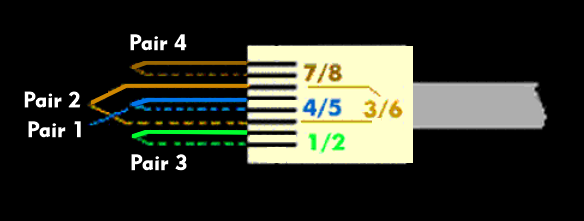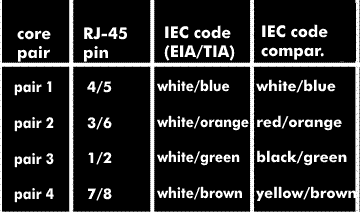RJ45 male connector (RJ45)
The RJ45 connector was specially developed for data transmission in networks. Thanks to continuous further development, this precision connector can be used for frequency ranges up to 250 MHz and, with some restrictions, also up to 600 MHz.
The RJ45 modular connector has been defined by ISO/ IEC JTC1/SC25/WG3 as standard ISO/IEC 11801 and is part of the universal cabling system. It is the most widely used of all data connectors and is used both in the terminal equipment connection area - in the TC junction box and on the connecting cable - and in the distribution panels for laying out and distributing the floor cabling.
Structure of the RJ45 connector
The RJ45 connector system is an eight-pole miniature connector system for use in connections with shielded and unshielded balanced copper cables. The RJ45 connector is an 8P8C connector. This means that it has 8 positions, which are occupied by 8 contacts. The 8 contacts of the connector are numbered consecutively; they are coated with a thin gold layer against corrosion and mechanical stress. The contact connections are located between guide rails; the cable connection is made using insulation displacement technology. On the side opposite to the contact side, the RJ45 connector has snap locking. This latch consists of a tab that locks the plug when it is inserted into an RJ45 jack. By pressing down the tab, the plug can be released and pulled out again. To avoid strong mechanical stress on the connected data cable, the RJ45 plug has a kink protection. This protection prevents the permissible bending radius of the connection cable from being exceeded.
The RJ45 plug is available in shielded and unshielded versions, whereby sufficient shield contact area should be ensured for the shielded version.
The transmission characteristics of the RJ45 plug are essentially determined by its small dimensions of 11 mm x 7 mm. The parametersfrequency range, attenuation, crosstalk, near end crosstalk( NEXT) and attenuation to crosstalk ratio( ACR) are essential for the transmission behavior.
The RJ45 connector in structured cabling
Within structured cabling, the connector characteristics must be adapted to those of the cables. For comparability and adaptability of the properties, the connectors are divided into categories, as are the data cables, the connecting cables, the patch cables and the other components within a cabling route. The categories represent different transmission properties in terms of bandwidth, attenuation, ACR and NEXT.
The cabling standards specify maximum values for these parameters for the different categories (3, 4 and 5). Whereby categories 3, 4 and 5 stand for transmission frequencies up to 16 MHz, 20 MHz and 100 MHz. Conventional RJ45 connectors do not meet the requirements for the higher categories 6 and 7. The small contact distances as well as the contact routing prove to be problematic for the high-frequency behavior. Only plug-in modules that have been optimized in terms of contact geometry meet the requirements up to category 6. Requirements for the transmission properties for categories 7 can only be achieved by assigning the outermost pin pairs, which considerably impairs flexibility. For this reason, the RJ45 connector is not intended for connection to category 7 cables. The GG45 connector, the ARJ45 connector and the Tera connector have been developed and standardized for this category.
In order to achieve a uniform assignment of the wire pairs to the RJ45 contacts, various institutions have defined color codes, which unfortunately are not uniform. The preferred color code is the IEC color code. There are also the DIN 47100 color codes, the REA color code and one based on IEC.
Unfortunately, the standardization committees for Ethernet or Token Ring and ISDN could not agree on a uniform assignment of this connector, i.e. different wire pairs are used. With four-pair cabling, this is completely uncritical, but with two-pair cabling, different connection cables must be used for the applications.



